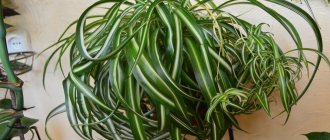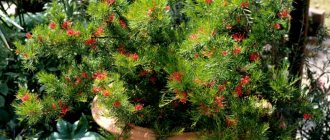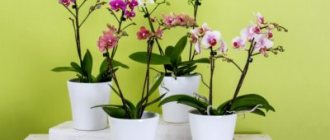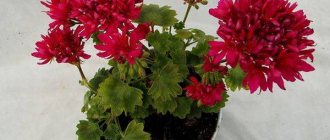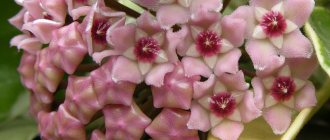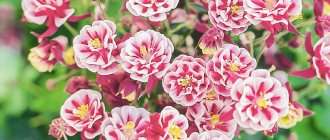Erica is most often used in garden floriculture, but some of its species can also be grown indoors. The plant is a shrub with delicate, needle-like, light green leaves. Belongs to the Vereskov family. When optimal conditions are created, Erica blooms very profusely with elongated “bells” of different colors. The flowering shrub is native to Africa.
Erica
Description
Erica is one of the representatives of the heather family, suitable for both landscape gardening and indoor floriculture. The plant is distinguished by a rich range of shades: you can plant Erica of different colors - and then the flowerbed or window sill in the house will become especially spectacular and picturesque.
As a rule, Erica is grown as an annual and dug up after flowering. However, the flowering is so long and decorative that it completely compensates for the short life of the plant.
Erica in landscape design
Erica in landscape design photo
The most impressive look is the erikary (a garden consisting of erik, heathers, and dwarf conifers). He looks neat, well-groomed, stylish. The size of the erikaria is at least 1 m². And the best shape is wavy, long or round; a square or triangle is absolutely not suitable.
Together they harmonize perfectly, since the requirements for soil and care are similar.
It makes sense to grow them together with heather, since they have a distinctive flowering period - the area will always be decorative. Place plantings on large lawns or along buildings, stone and wooden garden partitions, and gravel paths.
Erica in landscape design mixture of colors photo
Erica can be combined with the following conifers: pyramidal or columnar junipers, pony spruce, Cossack juniper, bird's nest spruce, microbiota, spherical thujas, dwarf pines, cypress trees. Also suitable as partners: dwarf birch, woolly willow, wintergreen, and hemlock. To add brightness, you can plant a couple of rhododendrons, which should be placed in the middle or in the background.
Erica in garden design photo
If the erikary is visible only from one side (located against the wall of a building or near a fence), place tall plants as the background, and place “little ones” in the foreground. If the composition is visible from all sides, plant tall plants in the center.
Erica and heather in the overall photo composition
Along the edges of the composition you can plant small-bulbous plants: scillas, muscari, snowdrops, crocuses, quinodoxa, narcissus, you can complement the picture with ground covers.
Ceramic figurines are inappropriate in erikaria. A wooden stump, a beautiful snag, or a boulder will fit in organically.
Kinds
Erica has many types - below is a detailed description of the most popular ones.
Herbal (ruddy)
A shrub reaching a height of no more than half a meter. If you plant several of these specimens side by side, the flowerbed will look like a solid, monochromatic carpet. Herbal Erica has about two hundred varieties, many of which are suitable for the climate of central Russia. Rarely cultivated at home, it is mostly used for landscape gardening. The color of this Erica is pink or crimson - very decorative.
Four-dimensional
A compact ornamental plant of gray-green, less often red, white or pink color. It is interesting because the leaves are collected in decorative whorls, making it especially impressive. Look at the photo of this wonderful plant.
Darlenskaya
A hybrid species that boasts particularly long flowering and a beautiful, elegant appearance. It is better to grow at home, since this Erica is not very resistant to frost. However, it is worth considering that the plant can reach a height of up to a meter, so not every corner of the apartment is suitable for it. The flowers have a pink, crimson or white tint.
Spiked
The small shrub can reach only 25 cm in height. Blooms in summer with soft pink inflorescences.
Gray (ash)
It reaches a height of 20-25 cm, has a decorative spreading crown. The flowers are ash-pink, the foliage is bluish. It grows better at home and does not tolerate cold winters.
Indoor “heathers” and their catchy beauty
Representatives of the Erica , which in nature are considered an invariable adornment of Scandinavian and British landscapes and are known mainly for the beauty of heathlands, are capable of surprising with their diversity. In the genus Eric, which is part of the family of the same name, there are more than 5 hundred species of plants. And although most of them remain wild plants, not introduced into garden culture, and the most famous Erics are garden plants, among the fifty thousand varieties there are also those species that will not refuse to be grown as a solo indoor plant. Genuine heathers (Calluna) are also grown indoors, but their maintenance requires a somewhat specific approach and the heather must be kept outdoors for most of the year.
Only two, but incomparable, types of Erica are grown as a houseplant - the herbaceous Erica (Erica herbacea), which has many magnificent varieties with different colors of inflorescences, and the less capricious, but also less spectacular Erica graceful (Erica gracilis). Both plants have many similarities in the type of flowering, size, and structure of the bushes. Moreover, almost all specimens presented on the modern market are hybrid varieties and their specific origin is sometimes not entirely easy to find out. And species plants are often confused with each other and sold under each other’s names. But you can still distinguish the herbal erica from the graceful one: the flowers of the first are colored only pink or red, while the flowers of the second are pink-lilac-purple. Everything else about the plants is very similar. Today they are actively experimenting with other types of Eric in the West, trying to increase the range of these plants in indoor representation, but there is no talk of any noticeable “breakthrough” of other types. On sale today you can sometimes find Erica Wilmore (Erica x willmorei) with long, up to 2 cm bell-shaped flowers and Erica ventricosa growing in the form of a spherical bush, but they can be found rarely.
On a note. If you have specimens of other species of heather or heather in your garden, you can try to grow them as houseplants using the cutting method and not transferring the plants after rooting to open soil, but replanting them in a pot and adapting them to indoor conditions from an early age. These are great plants to experiment with.
Erica gracilis
Indoor Ericas are low-growing, very dense evergreen shrubs, the maximum height of which does not exceed half a meter, and is often limited to 40 cm. The diameter of the bushes always exceeds their height; in healthy and strong specimens it can reach 60 cm or more. These shrubs are constantly growing and, if grown as perennials, require increasingly larger containers or timely division. Eric's shoots are erect, densely branched, and form a dense crown. The leaves are typical of all heathers, strikingly small, rich medium, light or dark green, needle-shaped, densely spaced, which creates a unique texture of the crown.
But despite all the beauty of the greenery, the most noticeable feature of indoor erikas, like their garden counterparts, remains flowering. The apical racemes or spike-shaped, elongated inflorescences, consisting of bell-shaped, often almost spherical, miniature, brightly colored flowers, captivate with both their amazing palette of colors and the ability to produce inflorescences in unimaginably large quantities. Small flowers in dense inflorescences harmonize with small leaves. During flowering, the bushes are so abundantly strewn with inflorescences that they turn into a single color (and texture) spot.
Indoor Ericas traditionally bloom on the eve of winter or at the very beginning and show off their flowers until spring. At this time, the rich shades of the red spectrum - pink, lilac, purple flowers - are unusual and unique, not found in any other plants except heathers, or the white-flowering elegant varieties of Erica seem to be an outlandish vision and real strangers in the interiors.
To be successful in growing indoor Ericas as perennials, it is enough to keep them cool. This is the main and basic requirement of these plants, but far from the only one. Erica can hardly be called an easy-to-grow crop; this plant is suitable only for experienced gardeners who are ready for difficulties and can provide this heather beauty with special care and special conditions. This is a plant for connoisseurs who are looking for original accents and non-standard solutions. All the difficulties in growing Erica are more than compensated for by its beauty. Today it is considered one of the most promising and fashionable among winter seasonal plants. But we are just beginning to take a closer look at it, and flowering bushes for indoor use are not very often found on sale.
Composition from Erica
Erica: a spectacular ornamental shrub from South Africa
Erica is an evergreen shrub from the Ericaceae family, native to South Africa. Some of the nearly 800 species known today grow in the Mediterranean.
Plant information
Erica leaves are needles 1 cm long , located throughout the stem. The stem is long, straight, stable. The small Erica flower resembles a bell. Flowers are collected in a brush. Their color varies depending on the variety and variety of Erica, usually white, pink and purple.
Erica's homeland is South Africa. It was cultivated in England in the 18th century. Since then, it has become popular in different countries of Europe and Asia. It came to the CIS countries from Germany in the 20th century.
Erica is used for landscaping, gardening and even as an indoor flower. This beautiful evergreen shrub pleases the eye for many years and does not require much effort to grow and maintain. However, in order for him to feel comfortable, he needs care.
Where to plant
Let's find out which places are best suited for growing the beautiful Erica.
If the plant is intended for home cultivation, it will feel best on a lit windowsill. However, it is necessary to protect the plant from drafts so that Erica develops safely and blooms for a long time.
You should also protect the plant from direct sun - shade the window at midday or place the pot directly in a place with diffused (but plentiful) light. The fact is that exposure to direct sunlight causes the petals to turn pale, thus losing the decorativeness and effectiveness of the plant. Also, the sun can lead to a decrease in the quality of flowering - a decrease in the number of inflorescences.
If Erica is intended to be grown in the garden, it is advisable to place it under the protection of a hedge. In this way, the plant will be provided with both shelter from direct sun and a sufficient amount of rarefied light. Erica is not planted in lowlands and hollows - it does not tolerate stagnant moisture. In waterlogged soil, the plant will be susceptible to fungal diseases.
Refined Erica plant: planting and care from an expert point of view
To make a culture feel “at home”, it is important to plant it in the right place. Most gardeners prefer to grow Erica flowers in open ground in a well-lit area. In the shade, the color of the foliage and inflorescences becomes pale. In addition, the life of the flower depends on the condition of the soil.
Therefore, the land is selected:
- With an acidic reaction. It is important to know that the root system of the crop is entwined with threads of fungal organisms that deliver nutrients to the plant from the soil/humus.
- Loose, water- and breathable. To obtain such a structure, add 1 part of sand and peat.
- Nutritious. It is necessary to regularly fertilize the area with humus and turf. In autumn or spring, fertilizer is scattered around the garden at the rate of 1 bucket per 3 m², and then the ground is plowed.
The culture does not tolerate stagnant water. Therefore, it is important to place it on slopes and not in depressions. On such plains, a lot of snow often accumulates, and when it melts, entire mini-oceans are formed.
Now it is important to become more familiar with all the intricacies of planting and caring for the Erica plant, so that you can then successfully apply its decorative properties in landscape design. Spring planting of shrubs is planned for early April, when the ground warms up to a temperature of +10˚C. Gardeners from the Moscow region carry out this procedure in May, and in Siberia even later.
Autumn planting is recommended only in the southern regions, provided that the winter is warm enough. In such cases, there is always the possibility of early frosts, due to which the seedling does not have time to take root in a new place.
Erica plant planting technology: “Measure 7 times, cut once”
3 hours before planting, the seedlings are immersed in warm water diluted with the growth stimulator “Kornevin”.
While the earthen ball becomes limp and undergoes special treatment, the gardener needs to carry out preparatory work:
- dig a hole 25x30 cm;
- make drainage at the bottom using coarse sand with crushed stone/expanded clay (layer up to 5 cm);
- fill the hole with a nutritious soil mixture: peat, sand, turf and humus.
The distance to the next specimen should be about 20-50 cm. To create a chic group planting, designers recommend using up to 5 Erica shrubs, which will grow luxuriantly by the 3rd year of life.
Then the gardener must carefully lower the seedling into the planting hole so that the root collar is flush with the surface of the earth. Fill the space with loose soil and carefully compact it. Finally, you need to water the planting generously with warm water. As soon as the liquid is absorbed, you can cover the flowerbed with mulch. To do this, use peat, dry grass, sawdust, pine needles or wood chips.
In many countries, the winter hardiness of Erica Darlenskaya is highly valued. Nevertheless, it is best to cover the bush for the winter. After flowering, the root circle is covered with peat or dry grass. Then a shelter is made from spruce branches, which will protect the plant from cold and condensation, and also significantly acidify the soil.
Features of cultivation
Let's find out the most important points regarding growing Erica at home.
Planting should be done in soil that has good drainage properties. As mentioned above, plants of this type cannot tolerate stagnant moisture. The soil needs to be loose, sandy; after watering, the soil should be loosened to provide air access to the roots of the plant.
The best soil in this case is considered to be the following mixture:
- peat - 3 parts;
- river sand - 1 part;
- turf soil - 1 part.
The plant blooms longest when kept in relatively cool conditions. If the air temperature is above +15 degrees Celsius, Erica will refuse to bloom for a long time, shortening the decorative period by several weeks.
Constant access to fresh air is very important for Erica - when growing this species at home, it is especially important not to forget about regular ventilation of the room.
Erika. Growing problems:
- Drying of shoots occurs at elevated temperatures.
- Leaves fall off when the soil dries out.
- Lack of flowering occurs when kept warm. It is necessary to lower the temperature to the recommended one.
Sources
- https://www.botanichka.ru/article/komnatnaya-erika/
- https://www.spas-agro.ru/tsvety/posadka-i-uhod-rasteniya-erika-v-otkrytom-grunte.html
- https://rastenia.info/tsvetyi/erika/opisanie-rastaniya.html
- https://agro-port.ru/grunt/erika-posadka-i-uhod-v-otkrytom-grunte-v-podmoskove.html
- https://zolotoesemechko.ru/jerika-v-domashnih-uslovijah/
- https://floplants.com/vereskovye/erika-pravila-ukhoda-peresadki-razmnozheniya/
[collapse]
Landing
Let's get acquainted with the features of planting Erica.
Young Erica seedlings are placed in the ground for permanent residence in early spring, before the start of active vegetation processes. If the transplant comes from a container, it can be done in the summer. Before planting, it is important to make sure that there are drainage holes at the bottom of the pot - this is important to ensure moisture circulation. Drainage is laid at the bottom, and only after that soil is poured.
If the plant is intended to be grown in the garden, you must dig a hole in advance. A depth of 20-25 cm will be enough - the roots of the plant are not too long. At the bottom of the dug hole, it is also necessary to lay a drainage layer of small bricks or crushed stone, and then pour the prepared soil on top.
The seedling (either in a pot or in a garden) is buried in the soil up to the root collar so that the latter is above ground level. If several specimens are planted at the same time, a distance of half a meter must be maintained between them.
Diseases and pests
Erica's roots are very thin, so they are easily susceptible to putrefactive processes. If the plant begins to shed its leaves, this may indicate a lack of light or rotting of the rhizomes. Erica can often be susceptible to powdery mildew. The disease must be controlled with fungicides.
Erica is often attacked by mites and aphids. To get rid of pests, you need to spray the leaves and stems with alcohol from a spray bottle. This should be done no more than once every 3-5 days, after removing the plant from the sunny side so that the remaining alcohol does not cause the leaves to burn. Commercial insecticides are also suitable for effective pest control.
Reproduction
Erica is usually propagated vegetatively. Young shoots are obtained from cuttings and by layering. Below are both methods in more detail.
Layerings
To get a viable, strong cutting of a plant, you need to take the strongest shoot from the apical one, separate it from the mother bush, dig it shallow into the ground and water it sufficiently. Secure the shoot with a hairpin so that it does not fall prematurely without having time to take root. The procedure is carried out in the spring: it is not advisable to carry it out in the summer and autumn, since the plant has less chance of successful rooting.
Cuttings
To obtain a cutting, it is necessary to cut off a small apical shoot (the strongest and strongest). The length of the shoot should be from seven to ten centimeters. Before rooting, the cuttings are treated with a root stimulator. Then drop it into a loose peat-sand mixture (2 parts peat, one sand).
During the rooting period, cuttings should not be exposed to light and heat, but in a cool place. The optimal temperature is +5-15 degrees. In addition, it is important to maintain optimal soil moisture. To make the cutting take root faster, you can cover the top of the pot with a plastic cap.
In addition to the methods listed above, Erica can be propagated by simply dividing one mother bush into several when transplanting. For professionals, the method is more complicated: with seeds. In this case, the seeds are planted in peat in the spring without being buried and germinated in a warm place under glass or film. But as soon as the first shoots appear, the container must be immediately placed in a cool place, and the young plants can then be grown there.
Medicinal and other beneficial properties
Erica gray and Erica crossifolia have medicinal properties. They are good diuretics and are used in the treatment of gout.
Some species are excellent honey plants.
Erica arborescens has valuable wood (briar) that is used to make smoking pipes.
- Author: Maria Sukhorukikh
Rate this article:
- 5
- 4
- 3
- 2
- 1
(0 votes, average: 0 out of 5)
Share with your friends!
Care
Let's learn how to properly care for a plant.
Watering, loosening
It is better to water Erica with soft, settled water that does not contain mineral impurities. In hot weather, the shrub needs more abundant watering, however, waterlogging and stagnation of moisture in the soil should not be allowed. It is advisable to carry out loosening immediately after watering. The procedure must be carried out shallowly, since the roots of Erica lie close to the surface.
Trimming
For the first 2-3 years after planting, Erica does not need pruning. After the third year, formative pruning is required every year (however, shallow). The procedure can be carried out either in the spring before the active growing season begins, or in the fall, when Erica has already faded. When pruning, cut off the upper part of the shoot to the inflorescences.
Top dressing
The plant is fed once a year - in the spring. It is advisable to use mineral fertilizers for feeding, since Erica does not tolerate organic matter well. Complex formulations like Kemira are optimal, but you can also use ready-made formulations for rhododendrons and azaleas.
Important: when you water the plant with a nutrient composition, make sure that the liquid gets only under the root and not on the leaves. Otherwise, a burn may occur.
Caring for Erica at home
Growing as a perennial requires experimentation and intuition, as the plant often behaves unpredictably. But for flower growers and gardeners who love a challenge, Erica has plenty of treats in store.
Lighting for Erica
It’s very easy to choose lighting for Erica. If the plants are located in living rooms or in any rooms in the house, then the plants need to be provided with a sunny place (if possible, then with protection from direct sunlight at midday in the summer), with the maximum possible brightness of lighting. If Erica is placed on a balcony, loggia, or taken out into the open air in the summer, then the place for this crop should be semi-shaded. Bright lighting quickly dries out the shoots and the plant becomes much more vulnerable to pests and diseases.
Comfortable temperature conditions
Selecting a comfortable temperature for Erica is considered a rather difficult task. For flowering, this plant is suitable for air temperatures up to 15 degrees Celsius, while Erica does well in warm rooms, provided there is access to air and good lighting: higher temperatures are easily compensated by increased air humidity. The longest flowering of this shrub can be observed at a temperature of 7-8 degrees on a cool loggia or balcony; at temperatures up to 15 degrees, flowering is reduced by several weeks.
In the summer, during the dormant period, this beauty feels great in almost any, even hot, conditions, but with one “but”: it is not sensitive to temperatures only when exposed to the open air. When kept indoors, Erica still prefers coolness or the maximum possible moderate temperature (18-20 degrees). At the end of autumn, to stimulate flowering, Erica should be placed in a cool place (5-10 degrees); it can also begin outside when the temperature drops, but you still need to monitor the weather and avoid even “zero” marks.
For this plant, it is extremely important to ensure constant ventilation, access to fresh air and free air circulation around the crown. Erica is rarely exhibited together with other plants; it requires a separate and fairly free location. It can be kept outdoors throughout the warm season; it thrives on balconies and terraces.
Group planting of Erica in flower pots
Watering and air humidity
This plant needs abundant watering, between which only the top soil in the pots should dry out. For Erica, it is important to maintain stable soil moisture. But at the same time, droughts will not be disastrous for the shrub, although they will negatively affect the intensity of flowering. If mistakes were made in watering, the substrate is too dry, then it is best to saturate the earthen ball by immersing the pot with the plant in a container filled with soft warm water until bubbles stop appearing, and then allow the excess moisture to drain completely. The water in the Erica trays should not be allowed to stagnate. If Erica is placed in a cool place, then watering for it should be very careful, but still maintain constant soil moisture.
The higher the air temperature, the more demanding this crop is in terms of air humidity. When kept cool, Erica can cope with even the driest conditions. If the readings exceed 15 degrees, then the air humidity should be increased to 60%. The optimal strategy for this shrub is to place humidifiers nearby or place the pot in containers filled with moist peat, pebbles, moss, expanded clay or decorative soils. In this case, the bottom of the container with Erica should not touch the water under any circumstances. Spraying for this shrub is undesirable during the flowering phase. If Erica is not yet blooming or you have enough dexterity to carry out spraying so carefully, wetting only the foliage, then these procedures will be quite comfortable for her.
Erica hates wiping leaves; and any form of showering or washing, even if the plant is affected by diseases or pests, cannot be carried out. Leaf polish and various foliage shine sprays cannot be used on this shrub.
Supplements for Erica
Fertilizers for this plant are applied at a standard frequency during the flowering period. Once every 2-3 weeks, add a standard, manufacturer-recommended dose of special liquid complex fertilizers for rhododendrons or other plants that prefer an acidic environment to the water for irrigation.
Erica gracilis
Trimming Erica
As such, Erica does not need formative pruning. The shrub naturally develops in the form of a stunningly compact plant with a dense crown that is constantly growing in width. But the plant definitely needs cleaning. True, individual fading flowers in inflorescences do not have to be plucked or removed. It is enough to periodically turn the plants thoroughly and shake them slightly so that the dried flowers fall off and you can remove them. After flowering, Erica is pruned to the height of the peduncles or slightly lower. Damaged, crumbling or dry branches should be removed immediately.
Wintering
If the plant is in a pot at home, it can overwinter on the same windowsill. Just water Erica less and do not carry out any care procedures before the growing season begins.
If the plant is in the garden, then some of its varieties will require additional winter shelter. If the climate is very harsh, then it is better to cover all specimens of Erica, regardless of the variety: this way there will be a greater chance that in the spring the plant will come to life and begin to grow.
In order to cover, the root circle is mulched with a layer (10 cm) of dry foliage or peat. The part of the plant that remains above the ground is covered with spruce branches. In the spring, as soon as the sun begins to warm up steadily, the cover with spruce branches is removed and the mulch layer is raked away.
Erica herbaceous. Erica herbaceae blooms
Despite the winter, Erica herbaceae or ruddy is now blooming in the southern coastal parks - a real prima of rockeries.
botanical certificate
grass erica or ruddy (erica herbacea syn. e. carnea) - a low shrub from the heather family, 35-60 cm high. The leaves are shiny, bright green, needle-shaped, linear, short, 4-8 cm long, collected in 4. flowers bell-shaped, drooping, small, 2-7 cm long, purple-pink, rarely white; bloom in (February - March) - April-May. fruits are small, brownish boxes. grows slowly. homeland: central and southern Europe. A large number of varieties have been bred.
Decorative varieties:
- 'March Seedling' (light pink flowers, remontant);
Website photo used: photoshare.ru
- 'Myretoun Ruby' (dark pink flowers, red stamens);
- 'Vivellii' (flowers dark red, leaves blackish-dark green, bronze after winter).
Website photo used: www.ua.all.biz
Growing area
The European part of Russia (in the north to the middle zone) and neighboring countries.
cultivation features
Erica is relatively winter-hardy: it can withstand temperatures down to -15°C, it is photophilous, prefers neutral or slightly acidic soils, a location protected from winds, and is sensitive to dry air and soil. pruning after flowering. Resistant to pests.
Reproduction
By seeds, cuttings, dividing the bush, vegetative varieties.
application
Erica is good in rocky gardens, winter container compositions, in free-growing, beautifully flowering low borders, with trimming of the sides if necessary.

